Description
Railroad Short Name: MILW
When EMD introduced its first road switcher models in 1952, there were two models. The first was the four-axle GP7, where GP was short for General Purpose. The second model was the six-axle SD7 and SD stood for Special Duty.
The first Special Duty handling trains where raw tractive effort was more important than speed. This included working mountain grades, hauling large transfer runs between yards, and heavy loads like iron ore trains. This became the primary usage of the SD series of locomotives for the next twenty years.
The second Special Duty was handling trains on light rail and over bridges with limited capacities. The SD7 could weigh as little as 125 tons, just a bit more than a GP7. Spread over six axles, that gave an axle-loading of 21 tons, much less than the 30 tons typical for GP7s.
Milwaukee Road had a considerable network of branch lines in Wisconsin, Minnesota, Iowa and North and South Dakota. Many of these branches had light rail and light bridges. Milwaukee purchased 24 SD7s and 14 SD9s plus similar six-axle locomotives from ALCo, Baldwin, and Fairbanks-Morse for those branch lines. By the late-1960s, these locomotives were aging and though mileage was reduced, Milwaukee still had branch lines that needed them. Milwaukee turned to EMD for a solution, the SDL39.
The SDL39 was 55 feet 2 inches long, shorter than a GP38 and weighed just 125 tons. Part of the weight reduction was the 12-cylinder turbocharged 645E diesel which produced 2,300 horsepower with four fewer cylinders than the non-turbocharged 645E engine in the GP38. The SDL39 rode on lightened export trucks and had a 1,700-gallon fuel tank.
The first five SDL39s were built on EMD Order Number 7135 as builder numbers 34272 through 34276 and delivered as Milwaukee Road numbers 581 through 585 in April 1969. The second order, Milwaukee Road numbers 586 through 590, was delivered in November 1972 on EMD order 7345 with builder numbers 7345-1 through 7345-5. All ten were Milwaukee Road class 23-ERS-6 (2,300 horsepower, EMD Road Switcher, 6 axle) and came in the standard orange and black paint scheme without Milwaukee Road lettering. Except for number 581 (which was always unique among the SDL39s), all eventually got the Milwaukee Road lettering.
The two orders differed in several ways. Between the two orders, EMD changed the pilot construction as well as the ECAFB. The first five units had four jacking pads on each side, while the second five had just two. The first order was delivered with snow shields over the air intakes, Prime PM-716 electronic bells, and no winterization hatch. The second order did not have the snow shields and were delivered with winterization hatches, Prime PM-733 electronic bells, and Stratolite rotary beacons.
In the 1970s, the first order lost their snow shields and gained winterization hatches and Stratolite beacons. All of the SDL39s came with all-weather windows on the engineer’s side and eventually lost the electronic bells in favor of standard bells mounted on the hood side just behind the cab.
SDL39 number 581 was wrecked in 1982 and scrapped two years later while the other nine units remained in service.
On February 19, 1985, Milwaukee Road merged into the Soo Line. All nine SDL39s became Soo Line units with at least numbers 582 through 585 getting the Soo “Bandit” paint with black patches covering the Milwaukee lettering and white Soo Line and numbers.
In 1986 and 1987, all nine were sold to the new Wisconsin Central. While working for Wisconsin Central, they would receive full WC paint as well as modifications like retention tanks and ditch lights.
When Canadian National took over WC, all nine were again sold, this time to Ferrocarril Del Pacifico, S.A. in Chile.
Road Number Specific ScaleTrains
- Milwaukee 583
- Era: late 1970s-1985
- Series Milw 581 to 585, built March/April 1969
- Data label and placement variations
- 81” low short hood with blanked cab heater louvers
- “Whip” radio antenna mounted on cab roof
- Snow shield brackets on rear of cab roof
- Front EMD-style low pilot snowplow with uncoupling lever clearance corners, MU hose doors, and grab irons; rear weed cutter plow
- “35-Line” cab with standard front windshields and blanked cab heater louvers
- Standard jacking pads at bolsters and extra jacking pads next to steps; total four (4) jacking pads per side
- 1,200-gallon fuel tank with single fuel filler, dual vertical fuel gauges, and round fuel gauge on both tank sides
- Milwaukee 585
- Era: late 1970s-1985
- Series Milw 581 to 585, built March/April 1969
- Data label and placement variations
- 81” low short hood with cab heater louvers
- Motorola ASP-16 “Firecracker” communications antenna mounted on cab roof
- Snow shield brackets removed
- Front EMD-style low pilot snowplow with uncoupling lever clearance corners, MU hose doors, and grab irons; rear weed cutter plow
- “35-Line” cab with standard front windshields and blanked cab heater louvers
- Standard jacking pads at bolsters and extra jacking pads next to steps; total four (4) jacking pads per side
- 1,200-gallon fuel tank with single fuel filler, dual vertical fuel gauges, and round fuel gauge on both tank sides
- Milwaukee 587, 588
- Era: Late 70’s to 1985
- Milwaukee Series 587 to 590, built November 1972
- Data label and placement variations
- 81” low short hood without cab heater louvers
- “35-Line” cab with standard front windshields and no cab heater louvers
- Forward rectangular cab vents on right cab side
- “Whip” radio antenna mounted on cab roof
- Front EMD-style low pilot snowplow with uncoupling lever clearance corners, MU hose doors, and grab irons; rear weed cutter plow
- Standard jacking pads at bolsters; total two (2) per side
- External toilet drain
- 1,200-gallon fuel tank with single fuel filler, dual vertical fuel gauges, and round fuel gauge on right tank side
- Milwaukee 589
- Era: Late 70s to 1985
- Milwaukee Series 587 to 590, built November 1972
- Data label and placement variations
- 81” low short hood without cab heater louvers
- “35-Line” cab with standard front windshields and no cab heater louvers
- Forward rectangular cab vents on right cab side
- “Whip” radio antenna mounted on cab roof
- Front EMD-style low pilot snowplow with MU hose doors and grab irons; rear weed cutter plow
- Standard jacking pads at bolsters; total two (2) per side
- External toilet drain
- 1,200-gallon fuel tank with single fuel filler, dual vertical fuel gauges, and round fuel gauge on right tank side
Features:
- Fully assembled
- Multiple road numbers
- Data label and placement variations
- Operating LED-lit tricolor (red, green, and white) flush-mounted class lights with raised gasket**
- Directional LED headlights
- Operating LED-lit cab interior and control stand lights*
- Operating LED-lit front, rear, and fireman’s side walkway lights*
- Operating LED-lit ground lights on both sides of locomotive
- Printed and LED-lighted number boards
- Front EMD-style low pilot snowplow with MU hose doors and grab irons; rear weed cutter plow
- Front and rear early small deck extension
- No drop steps
- Stepwells with see-through steps; front edges painted white
- Scale sectioned “late” pattern walkway treadplate
- Front and rear Multiple Unit (MU) stands
- Latched battery box doors with narrow louvers
- Latched cab sub-base doors with early hinges
- 81” low short hood with cab heater louvers
- Drop grabs and standard nut-bolt-washer (NBW) mounting on nose front and top
- “35-Line” cab with standard front windshields and cab heater louvers
- Standard EMD high headlight in numberboard housing
- Detailed cab interior with separate floor, rear wall, seats, and standard AAR control stand
- Sliding cab windows
- All weather window on right cab side; short mirror mounted in front of window on left cab side
- No sunshades
- Standard EMD arm rests
- Motorola ASP-16 “Firecracker” communications antenna mounted on cab roof
- Ratchet brake with chain
- Small ECAFB
- Early (smooth) blower duct housing
- Inertial air intake grilles without drip rails
- Standard corrugated air filter screens
- Separately applied dust bin and exhaust stack
- Non-dynamic brake
- “Chickenwire” radiator grilles
- Standard-height fan housings with 9-blade radiator fans visible inside
- Photoetched concentric ring fan grilles
- No winterization hatch
- Front and rear straight uncoupling levers with four mounting brackets
- Handrail set with pilot face mounted outer end rail stanchions and solid railing
- 4-hose MU hose clusters with silver gladhands
- Late deck-mounted MU receptacle
- Pilot face bracing detail behind stepwells
- Underbody frame rail with separate plumbing and traction motor cables
- Standard jacking pads at bolsters and extra jacking pads next to steps; total four (4) jacking pads per side
- Sill-mounted EFCO button
- Air tanks with plumbing
- Salem air filter (accordion style)
- 1,200-gallon fuel tank with single fuel filler, dual vertical fuel gauges, and round fuel gauge on both tank sides
- Detailed light weight EMD C-C export trucks with Hyatt bearing caps and separate brake cylinders, brake lines, and outboard sanding lines
- Speed recorder mounted on the second axle, left side
- Paint colors matched to Tru-Color Paint: TCP-111 Milwaukee Road Orange
- Factory-applied wire grab irons, wire lift rings, windshield wipers, horns, coupler cut levers, trainline hoses with silver gladhands, sand hatch covers, and much more
- Semi-scale coupler buffer equipped with durable metal semi-scale Type “E” knuckle couplers
- All-wheel drive
- All-wheel electrical pick-up
- Motor with 5-pole skew-wound armature
- Dual flywheels
- Printing and lettering legible even under magnification
- Operates on Code 70, 83 and 100 rail
- Packaging safely stores model
- Minimum radius: 18”
DCC & sound equipped locomotives also feature:
- ESU LokSound 5 DCC & Sound decoder with “Full Throttle” feature
- Dual cube-type speakers
- EMD 12-Cylinder 645E3 turbocharged prime mover sounds
- Curve squeal and frog clank sounds*
- ESU designed “PowerPack” with two super capacitors***
- Operates on both DC and DCC layouts

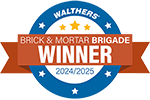
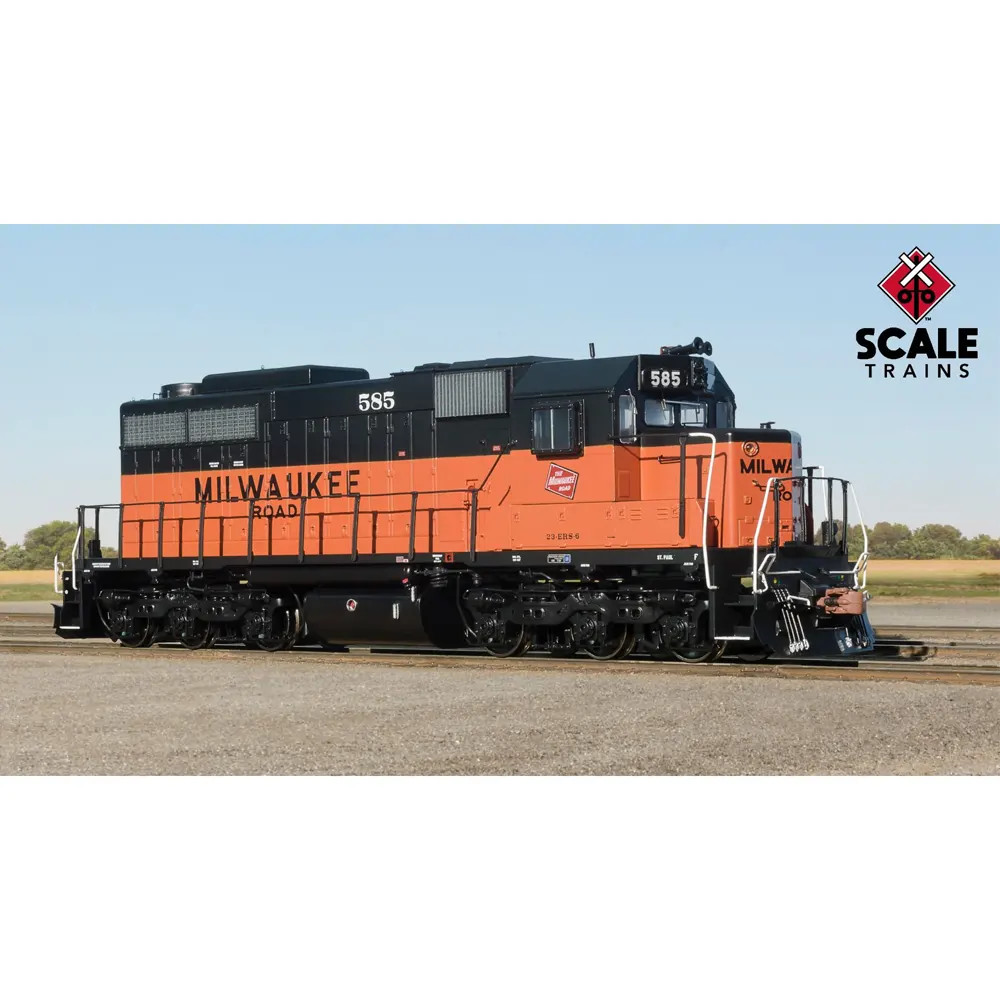
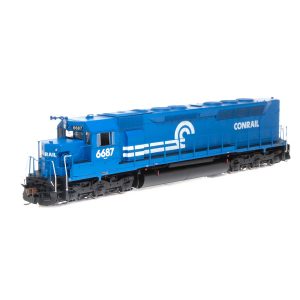
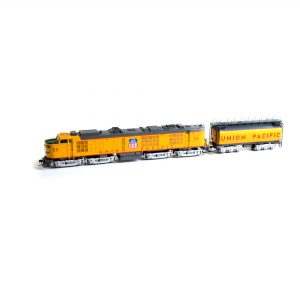
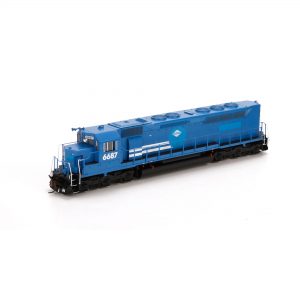
Reviews
There are no reviews yet.